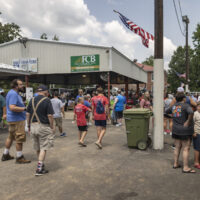When Robert Penn Warren wrote “The Circus in the Attic” and made it the title story of his only collection of short fiction, published in 1947, he might have owed some of the inspiration for that piece to a Hopkinsville family.

Warren’s story is about a man named Bolton Lovehart, who ruminates on his childhood adventure of running off with the circus and avoids his dominate mother by escaping to the attic to build a model circus. The character is believed to be loosely based on John Wesley Venable Jr., the son of an Episcopal priest and a native of Hopkinsville who was born in 1888. Venable, as Warren likely heard, found his own escape by assembling a menagerie of circus pieces while sharing a home with his mother until her death in 1938.
A portion of the Venable circus, including a calliope made with old lipstick tubes and a circus train car crafted from a cigar box with bottle caps for wheels, is in the collection of the Pennyroyal Area Museum.
According to local legend and literary critics who have written about the short story, Warren, a native of Guthrie, heard of Venable while visiting the home of Hopkinsville merchant Kenneth O. Cayce Sr., perhaps in the 1930s.
Venable, who died in 1976, was the son of the Rev. John Wesley Venable Sr. and his second wife, Anne Frances “Fannie” Peyton Moore. The father was a native of Washington, D.C. He had moved to Hopkinsville in 1882 to become rector of Grace Episcopal Church and remained here following his retirement in 1895. The younger Venable managed movie theaters in Hopkinsville.

The elder Venable left behind several diaries, drawings and paintings that are part of family archives preserved at Western Kentucky University’s Special Collections Library in the Kentucky Building on campus.
A blog entry for WKU Libraries describes how a creative influence in the younger Venable’s life likely inspired his circus creation.
The entry includes the following:
“At an early age, his father taught John Jr. the rudiments of drawing. He spent many hours drawing, reading and constructing a large circus menagerie that was kept in the garret of the family home. He spent most of his life as a manager of movie theaters in Hopkinsville. He married Alice Lacey in 1942.
“The story of his circus menagerie was well known in the area, and it was passed on to Todd County native and author Robert Penn Warren by Frank Quarles Cayce of Hopkinsville. Warren used Venable … and his mother as prototypes for Bolton Lovehart and Mrs. Simon Lovehart in his novella, ‘The Circus in the Attic.’ (Venable) is buried with his wife in Hopkinsville’s Riverside Cemetery. The collection contains many of John’s fanciful drawings of circus and adventure scenes. A portion of the circus menagerie is owned by the Pennyroyal Museum in Hopkinsville.”
Warren, who died in 1989, received the Pulitzer Prize for his novel “All the King’s Men” in 1947 and twice earned the Pulitzer for Poetry, in 1958 and 1979. He remains the only recipient for both fiction and poetry and one of only nine writers to receive at least three Pulitzers in the arts and letters categories.
Warren set “The Circus in the Attic” in a tobacco town he called Bardsville.
Here is a portion of the story that introduces Bolton Lovehart:
“Bolton Lovehart … lives in an old brick house, halfway down the slope of Rusty-Butt Hill toward the square. The big houses of Bardsville, with the exception of a few new ones built in the flush times of the 1920’s in a subdivision called Chilton Heights near the country club, are on Rusty-Butt Hill. They began to build the big houses on the hill more than a hundred years ago when the lucky sons among the sons of the pioneers were turning into land speculators and tobacco planters who shipped leaf down the river.”
The Venable home in Hopkinsville, where the circus pieces were assembled, stood on South Virginia Street at 14th Street. It was torn down around 1980, said Christian County Historian William T. Turner.
Jennifer P. Brown is co-founder, publisher and editor of Hoptown Chronicle. You can reach her at editor@hoptownchronicle.org. Brown was a reporter and editor at the Kentucky New Era, where she worked for 30 years. She is a co-chair of the national advisory board to the Institute for Rural Journalism and Community Issues, governing board past president for the Kentucky Historical Society, and co-founder of the Kentucky Open Government Coalition. She serves on the Hopkinsville History Foundation's board.





